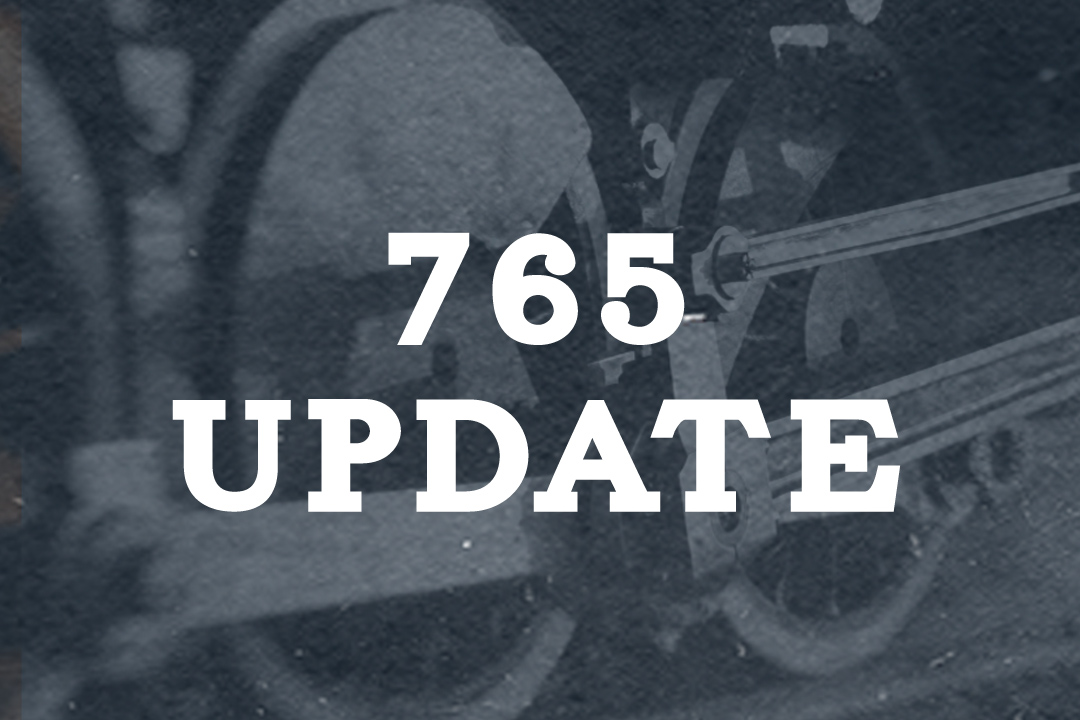Submitted by Steve Winicker
LAST WEEKENDS SHOP ACTIVITY
Monday was spent untangling and hanging electrical cords, fixing grinders washing parts of the 765 that had been dusted with coal dust, straightening tool pile and thawing frozen locks on the building. After all that work, I had to get rested up, so Tuesday and Wednesday were spent on personal projects in need of attention. Thursday I was off to a late relaxed start when Grant called and asked where I was. I hurried out to the shop and got Grant started on scaling the coal bunker as needed. He did a masterful job with only minor assists from yours truly. I spent the day looking for wood for the caboose project and we decided to stop at a reasonable hour. Friday Grant beat me to the shop again and started painting the coal bunker. Rich B arrived and worked on the Boxcar followed by Rich W who worked on the caboose. These were followed by Tim who crawled in the tender and began needle gunning rust on the inside and shaking the paint Grant was applying on the inside so it would have a smooth finish. Joe Nemeth arrived and assisted with the caboose work followed by some shop organization and assisted Grant in painting the coal bunker. Saturday Austin, Samantha, and Grant finished painting the coal bunker. Grant followed up with some work on drilling out tell tales. Tim went in and needle gunned the tender’s inside, completing most of the right-side water leg. On the Wabash caboose some floor was removed and replaced. Rich removed and replaced the top of the east end of the car’s back wall. Sunday was off to a great start. DJ needle gunned the inside of the tender. Grant finished up drilling tell tales on the outside of the firebox. Several projects marked off the to do list.
UPCOMING ACTIVITIES
Since we need to move projects along. Cleaning up and painting the interior of the tender will remain the focus of work. Staybolt drilling inside the firebox is still needed as well in case we get more needle gunners than we have needle guns. Those who have participated report that tender scaling is as much fun as is humanly possible to have. We are taking reservations for space get your spot reserved before they are gone. .
SAFETY SENSE
Most injuries associated with snow blowers involve injuries to the hand or finger, including amputation. Often the operator tried to clear a clogged auger or discharge chute with their hands.
No matter what kind of snow blower you’re using, here are a few basic steps to follow to help keep you and others from being injured.
- Turn off the engine on a gas machine or unplug the motor on an electric model before clearing a clog at the auger or discharge chute. Then use the clearing tool or stick, NEVER hands or feet, to remove the clog.
- Always assume that when the engine is running, the auger is spinning.
- Protect yourself from carbon-monoxide poisoning by starting and running gasoline-powered snow blowers outside while warming up the engine. Never run the blower in the garage or shed during warm up.
- Don’t wear loose pants, jackets, or scarves, which can get tangled in a snow blower’s moving parts.
- Wear sturdy footwear with good traction.
- Exercise caution when operating on slopes or graded areas.
- Wear ear plugs or other hearing protection as necessary.
- Wear eye protection as objects, such as stones and other driveway debris can fly and/or ricochet.
- Thoroughly mix fuel to the proper gas/oil ratio for two cycle engines. Immediately cleanup any spilled fuel. Do not mix the fuel near and ignition source or open flame.
- Add fuel to the machine only when the engine is off and cooled.
- Use an approved fuel container to store the gasoline.
- For electric models, use an outdoor extension cord and an outlet with ground-fault-circuit-interrupting protection. Then be sure to keep the cord safely away from the spinning auger while working.
- Never direct the discharge chute toward people or areas where damage can occur. The blower can discharge hard objects much further than it can discharge snow.
Following these tips will help keep you safe. Clearing clogs is the number one cause of snow-blower-related injuries. Take special care when clearing clogs by ALWAYS making sure the machine is off and NEVER use your hands or feet to clear a clog. Use a clearing tool or stick instead.
SAFETY IS JOB 1
SAFETY FIRST ALWAYS


